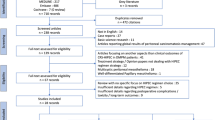Abstract
Background
Cytoreductive surgery with intraperitoneal hyperthermic chemoperfusion (IPHC) has evolved into a promising approach for peritoneal surface malignancy. A large body of literature suggests that oxaliplatin has excellent cytotoxicity against colorectal cancer. Therefore, we undertook a phase I evaluation of IPHC with oxaliplatin for peritoneal dissemination from colorectal and appendiceal cancers to establish the dose-limiting toxicity (DLT) and the maximum tolerated dose (MTD).
Methods
Cohorts of three patients underwent cytoreductive surgery followed by a 2-h IPHC with escalating doses of oxaliplatin at a target outflow temperature of 40°C. The initial peritoneal oxaliplatin dose was 200 mg/M2 with increases planned in 50 mg/M2 increments. Plasma and perfusate samples were collected during the IPHC and evaluated using emission spectrometry techniques. Normal tissue and tumor samples were collected before and after the IPHC for analysis. DLT was defined as a grade 3 toxicity lasting 5 days.
Results
Fifteen patients were enrolled at two dose levels. Peritoneal fluid areas under the curve (AUCs) were above those of plasma. Additionally, intratumoral oxaliplatin was similar to that of surrounding normal tissue. Dose-limiting toxicities at 250 mg/M2 were observed in two of three patients enrolled in this study.
Conclusion
We found that IPHC with 200 mg/M2 of oxaliplatin is well tolerated and is the MTD for a 2-h chemoperfusion. Higher doses are not feasible with this perfusion protocol given the significant toxicities associated with 250 mg/M2 oxaliplatin. Based on the data from this phase I study, we propose to conduct further studies with oxaliplatin delivered at 200 mg/M2.


Similar content being viewed by others
References
Blair SL, Chu DZ, Schwarz RE Outcome of palliative operations for malignant bowel obstruction in patients with peritoneal carcinomatosis from nongynecological cancer Ann Surg Oncol 2001; 8:632–7
Jayne DG, Fook S, Loi C, et al. Peritoneal carcinomatosis from colorectal cancer Br J Surg 2002; 89:1545–50
Koga S Prophylactic and therapeutic continuous hyperthermic peritoneal perfusion for peritoneal metastases of gastric cancer Gan No Rinsho 1985; 31:1103–5
Levine EA, Stewart JH, Russell GB, et al. Cytoreductive surgery and intraperitoneal hyperthermic chemotherapy for peritoneal surface malignancy: experience with 501 procedures J Am Coll Surg 2007; 204:943–53
Stewart JH, Shen P, Levine EA Intraperitoneal hyperthermic chemotherapy for peritoneal surface malignancy: current status and future directions Ann Surg Oncol 2005; 12:765–77
Stewart JH, Shen P, Russell GB, et al. Appendiceal neoplasms with peritoneal dissemination: outcomes after cytoreductive surgery and intraperitoneal hyperthermic chemotherapy Ann Surg Oncol 2006; 13:624–34
Shen P, Hawksworth J, Lovato J, et al. Cytoreductive surgery and intraperitoneal hyperthermic chemotherapy with mitomycin C for peritoneal carcinomatosis from nonappendiceal colorectal carcinoma Ann Surg Oncol 2004; 11:178–86
Dedrick RL, Flessner MF Pharmacokinetic problems in peritoneal drug administration: tissue penetration and surface exposure J Natl Cancer Inst 1997; 89:480–7
Flessner MF, Dedrick RL, Schultz JS A distributed model of peritoneal-plasma transport: theoretical considerations Am J Physiol 1984; 246:R597–607
Rixe O, Ortuzar W, Alvarez M, et al. Oxaliplatin, tetraplatin, cisplatin, and carboplatin: spectrum of activity in drug-resistant cell lines and in the cell lines of the National Cancer Institute’s Anticancer Drug Screen panel Biochem Pharmacol 1996; 52:1855–65
Atallah D, Marsaud V, Radanyi C, et al. Thermal enhancement of oxaliplatin-induced inhibition of cell proliferation and cell cycle progression in human carcinoma cell lines Int J Hyperthermia 2004; 20:405–19
Urano M, Ling CC Thermal enhancement of melphalan and oxaliplatin cytotoxicity in vitro Int J Hyperthermia 2002; 18:307–15
Elias D, Bonnay M, Puizillou JM, et al. Heated intra-operative intraperitoneal oxaliplatin after complete resection of peritoneal carcinomatosis: pharmacokinetics and tissue distribution Ann Oncol 2002; 13:267–72
Kuzuya T, Yamauchi M, Ito A, et al. Pharmacokinetic characteristics of 5-fluorouracil and mitomycin C in intraperitoneal chemotherapy J Pharm Pharmacol 1994; 46:685–9
Levi F, Metzger G, Massari C, et al. Oxaliplatin: pharmacokinetics and chronopharmacological aspects Clin Pharmacokinet 2000; 38:1–21
Blacher C, Neumann J, Jung LA, et al. Off-pump coronary artery bypass grafting does not reduce lymphocyte activation Int J Cardiol 2005; 101:473–9
Bolla G, Tuzzato G Immunologic postoperative competence after laparoscopy versus laparotomy Surg Endosc 2003; 17:1247–50
Hauser GJ, Chan MM, Casey WF, et al. Immune dysfunction in children after corrective surgery for congenital heart disease Crit Care Med 1991; 19:874–81
Shen P, Levine EA, Hall J, et al. Factors predicting survival after intraperitoneal hyperthermic chemotherapy with mitomycin C after cytoreductive surgery for patients with peritoneal carcinomatosis Arch Surg 2003; 138:26–33
Verweij J, den Hartigh J, Stuurman M, et al. Relationship between clinical parameters and pharmacokinetics of mitomycin C J Cancer Res Clin Oncol 1987; 113:91–4
Elias D, Pocard M, Goere D HIPEC with oxaliplatin in the treatment of peritoneal carcinomatosis of colorectal origin Cancer Treat Res 2007; 134:303–18
Acknowledgements
This study was supported by an Investigator Sponsored Trial grant from Sanofi–Aventis. The authors wish to acknowledge James E. Medlin, Kathryn E. Pharr, Summer N. Hanna, Jiyan Gu, Amal S. Essader, and Carl G. Young for their assistance in evaluating platinum levels in the clinical samples.
Author information
Authors and Affiliations
Corresponding author
Additional information
An erratum to this article can be found at http://dx.doi.org/10.1245/s10434-012-2308-4.
Rights and permissions
About this article
Cite this article
Stewart, J.H., Shen, P., Russell, G. et al. A Phase I Trial of Oxaliplatin for Intraperitoneal Hyperthermic Chemoperfusion for the Treatment of Peritoneal Surface Dissemination from Colorectal and Appendiceal Cancers. Ann Surg Oncol 15, 2137–2145 (2008). https://doi.org/10.1245/s10434-008-9967-1
Received:
Revised:
Accepted:
Published:
Issue Date:
DOI: https://doi.org/10.1245/s10434-008-9967-1




